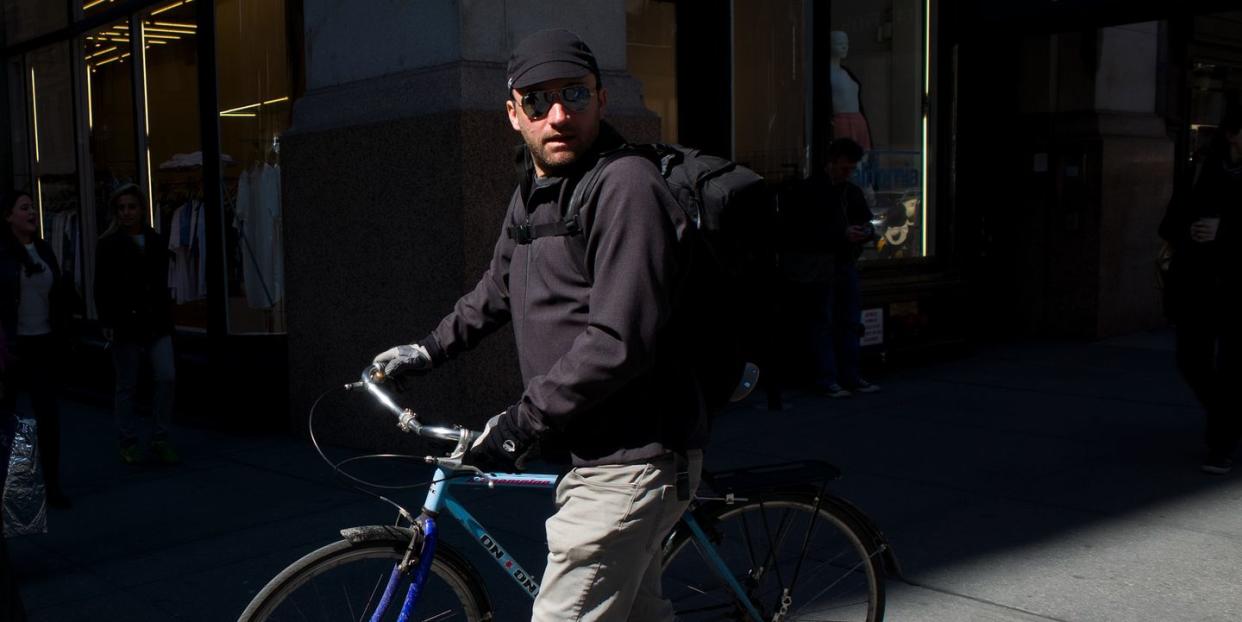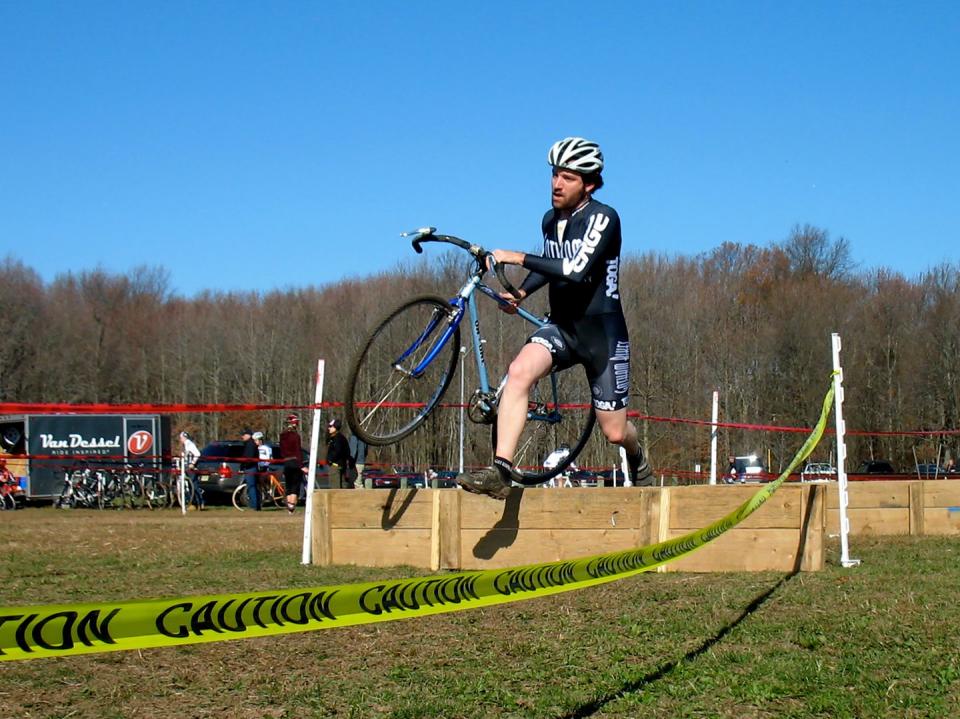I Rekindled My Love of Riding Alone, and Rediscovered the Spontaneous Joy You Find From the Ride

Twenty-five years ago, I was a clueless 21 year-old living in Brooklyn, trying to figure out both cycling and life. While I’d grown up riding and racing BMX, when it came to bikes with 700c wheels I knew nothing about training or technique. But I savored the sensation of the road beneath my tires and yearned to put miles between myself and my home. So in my spare time I’d just pick a direction and ride.
I lived alone and I rode alone, and I made a lot of mistakes.
My bike was the too-big Univega hybrid my several-inches-taller brother never really used. Blissfully free from sartorial concerns, I’d wear a pair of Lycra half-shorts and a cut-off t-shirt, or if it was really hot I’d forego the shirt altogether. I carried my wallet and keys in a fanny pack. What I didn’t carry were tools, tubes, or a pump. Or food. Rarely did I have any kind of destination or route in mind, and there wasn’t much in the way of bike infrastructure to guide me. I just roamed the city and its environs—a young, shirtless, fanny-packed foal on an oversized bike.
The Univega and I parted ways when I rode it to work in Manhattan and a thief easily defeated the bike lock I had made for myself on the cheap with a chain and padlock from the hardware store. I replaced the hybrid with a Cannondale road bike, and when I wasn’t riding it I’d gaze lovingly at its oversized tubes and seamless welds. I started using foot retention, wearing a cycling jersey, and carrying supplies in a saddle bag. The bike dominated my studio apartment as well as my affections. I didn’t ride the Cannondale to work, but I hated leaving it so much every day that I left my job instead. I then answered an ad in the Village Voice, wrapped my bike in inner tubes, and went to work as a bicycle messenger.
On my first morning as a messenger, I and a handful of fellow newbies received a debriefing from the general manager. The gist of it was, “Don’t lose any packages, and don’t die.” Then he sent us out into the streets. Shy and insecure, I was not a part of the bicycle messenger subculture, nor did I ever really gain entree into it. The only person I interacted with on a regular basis was my dispatcher, who I’d call from a payphone, using the 10lbs of quarters I kept in the pocket of my cargo pants. I was alone, but I was on my bike, where I was always happiest.
Get Full Access to Bicycling.com Now
Then my beloved bike got stolen. I’d invested in a decent lock this time, but I’d locked the bike to the leg of a mailbox, which the thief unbolted from the sidewalk. Demoralized and defeated by the streets, I went to work in an office again. I bought myself another Cannondale, this time with a carbon fork, which seemed impossibly exotic. I also started spending more time at the bike shop, and became friendly with the owners. They invited me to ride with them, and they suggested I try racing. So one cold early spring morning before sunrise I showed up to a Cat 5 race in Central Park.
While I was nervous, I also fancied that with my street-honed cycling chops I’d send it to these soft roadies and show them how it was done. I was wrong. Within minutes my heart rate was pegged, and I got dropped after half a lap; it was the hardest thing I’d ever done on a bike. Nevertheless, the intoxicating mix of adrenaline and lactic acid was immediately familiar to me from my BMX racing days. So I signed up again, and again, and for the first time since my adolescence I was a bike racer.
Bike racing also involved something else I hadn’t done since childhood, which was ride in a group. As kids we used to rip around the neighborhood in small packs on our BMX bikes, trying to outsprint each other. Now my new teammates and I rode up and down Route 9W week after week, trying to outsprint each other. And while I’d undertaken my journey from fanny pack to messenger bag under my own tutelage, I now had older and wiser riders to guide me in everything from strategy to technique to equipment choice to where to find dirt roads and steep climbs. Sure, I was still making my own mistakes, such as using the bathroom immediately after applying embrocation (DEAR GOD, IT BURNS!!!). But you don’t figure out bike racing all by yourself, and perhaps the most effective teaching technique in a group setting is good-natured heckling. When you start riding in pacelines and showing everyone your crack, you learn quickly why not to wear half shorts.
The people I rode with became my friends and my support network. We celebrated weddings, we saw each other through break-ups, and we helped each other move. Riding with people also meant I started riding more than I’d ever ridden before. I showed up for every crack-of-dawn race, and after that we’d pick up the group ride for base miles, or jump in the car and go mountain biking in order to get stronger and faster. I did some mountain bike races, I started racing cyclocross. Once I reached Cat 3 on the road I never saw the front end of the pack again, but it didn’t matter. I was in it for the speed, and the rituals, and the camaraderie, and that stoned feeling of post-race bliss. Life was something that happened between rides, and if I couldn’t feel that last ride in my legs then it was time to ride again.

Riding in a pack is exhilarating, but it’s also hard. To be part of any group, on or off the bike, you’ve got to put in the work. If you’re not punctual the group leaves without you. If you don’t pull your weight you get dropped. If you make a mistake you take everyone else down with you. On a good day you’re a remora riding a shark, but on a bad day you’re turning yourself inside out because you’re 40 miles from home and you don’t want to get stranded in Connecticut.
But sometimes it’s good to get “stranded” in Connecticut. One of the greatest things about riding a bicycle is that it allows you to disappear, and to lose yourself in something that’s bigger than you are. As much as I loved losing myself in the group, I also missed the days when I’d lose myself in the city, or the landscape beyond the city, or in my own thoughts. My bikes, my wardrobe, and my riding routine were now all built around keeping up with other riders. I was binging on miles instead of savoring them. In a way, I was treating cycling like a job. Certainly I put more effort into it than my actual job, which I treated as disdainfully as a roadie treats “junk miles.” I longed to leave my job, but I also caught myself fantasizing about leaving bike racing and retiring to a lifestyle of fat tires and fenders.
So I built myself a practical city bike and started losing myself in my commute. For an hour every morning and evening I was that messenger again, riding the cross sea of motor vehicle, bicycle, and pedestrian traffic. While I’d had my head down and my hands in the drops, New York City had built a bunch of bike lanes, and I found myself marveling at the proliferation of new cyclists on color-coordinated fixies. Then I started working from home, and became a father. Parenting, not bike racing, dictated my schedule. We moved to a different neighborhood, far from the parks where the races happen, but much closer to the open roads and dirt trails beyond the city limits. I was a solo rider once again.
At first I’d wake up before dawn during the racing season, knowing that everyone was pinning on numbers and gathering on the start line, and it was hard to get back to sleep again. But soon it got easier, until it became a relief. I rode when I had time to ride, and I realized that for all the “mistakes” I’d made in my early days I’d also done a lot right. I stopped worrying whether my kit matched, and then I stopped bothering with a kit at all, forsaking the Lycra for t-shirts and cutoffs. I explored my new territory, I found hidden networks of quasi-legal singletrack, I rode as fast or as slow as I wanted, I stopped when I felt like it, and I rediscovered the spontaneous joy you find when you just pick a direction and ride—but on a bike that fits, and with the knowledge that only comes from grinding it out for years on end.
It can feel great to finish with the group, but it can also feel great to sit up and let the group go. You never lose the knowledge, or the memories, or the friends. Don’t worry, you can always jump in again.
You Might Also Like

